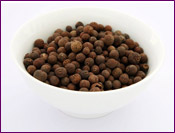Allspice Essential Oil (Pimento Berry/Leaf)
 |
|
| Allspice Berries | |
Allspice Oil is a wonderful oil to use in the diffuser during the fall and winter. If used at full-strength, it can be a potent mucous membrane irritant, so it's best blended at a low ratio with other essential oils before diffusing. I particularly like Allspice Oil blended with Orange Oil or Bergamot Oil. Allspice Essential Oil's high Eugenol (a phenol) content suggests that Allspice may act as an anti-viral oil.
Allspice Essential Oil, in small dilutions, is said to act as an aphrodisiac. Its rich, warm aroma also complements masculine blends.
Although Allspice Oil is regarded for its use within personal fragrancing, massage, arthritic and muscular applications, Allspice Oil can be a dermal irritant. If you choose to use Allspice Oil within topical applications, be certain to dilute it very well.
Aromatic Description: Allspice Essential Oil is sharp yet sweet with a spicy, cinnamon and clove-like aroma.
Allspice Oil Uses: Arthritis, muscle tone, stiffness, rheumatism, muscular and gastric cramps, indigestion, nausea, depression, nervous tension/exhaustion, neuralgia, coughs, bronchitis. [Julia Lawless, The Illustrated Encyclopedia of Essential Oils (Rockport, MA: Element Books, 1995), 60-65, 194.]
Constituents: Eugenol, methyl eugenol, cineol, phellandrene and caryophyllene. [Julia Lawless, The Illustrated Encyclopedia of Essential Oils (Rockport, MA: Element Books, 1995), 194.]
Safety Information: Lawless and Tisserand indicate that Allspice Oil may be a mucous membrane and derman irritant. Significant dilution suggested. [Julia Lawless, The Illustrated Encyclopedia of Essential Oils (Rockport, MA: Element Books, 1995), 194.] Tisserand also mentions that it is contraindicated in those with haemophilia and/or liver disease. [Robert Tisserand, Essential Oil Safety (United Kingdom: Churchill Livingstone, 1995), 221.]
Important Note: The essential oil
information provided within the Essential Oil Properties & Profiles
area is intended for educational purposes only. This data is not
considered complete
and is not guaranteed to be accurate.
General Safety Information: Do not take any essential oils internally
without consultation from a qualified aromatherapy practitioner. Do not apply
undiluted essential oils, absolutes, CO2s or other concentrated essences onto the skin. If you are pregnant, epileptic, have
liver damage, have cancer, or have any other medical problem, use essential oils
only under the proper guidance of a qualified aromatherapy practitioner. Use
extreme caution when using oils with children and give children only
the gentlest oils at extremely low doses. It is safest to consult a qualified
aromatherapy practitioner before using essential oils with children. A skin
patch test should be conducted prior to using an essential oil that you've never
used before. Instructions on conducting a skin patch test
and more safety information can be found by visiting the Essential Oil Safety
Information page. For very in-depth information on essential oil safety
issues, read Essential Oil Safety by Robert
Tisserand and Tony Balacs.
No comments:
Post a Comment